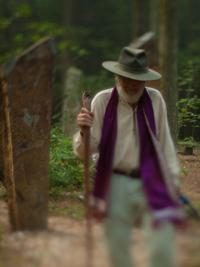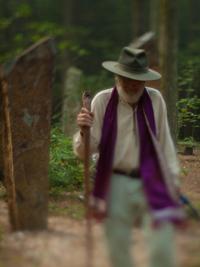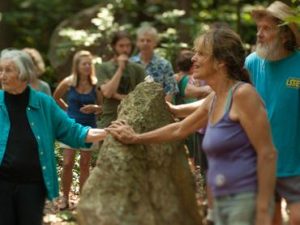As in tribes, elders in intentional community are those who have visioned, initiated, developed, guided, nurtured, and anchored their groups over the decades. Elders are traditionally those who hold essential wisdom and knowledge for the group and sustain it by the respect and trust they gain and the practical value of their experience. They also offer essential reflection.
“Elders have experienced enough of the stages of life that they can look back and reflect on them, and this really can’t happen before 50 and maybe not before 60. Sometimes, though, a younger person surprises everybody with their wisdom and is considered an elder.” —Erjen Khamaganova, Siberian Indigenous Leader [email to author, May, 2012; see also Wild Earth, Wild Soul: A Manual for an Ecstatic Culture, Bill Pfeiffer, Moon Books, Winchester, UK, 2013]
To gain a closer look at contemporary Elder presence, I visited a thriving intentional community in western Massachusetts, Sirius Community.
Sirius was founded in 1978 and named for the Dog Star. It is a “seed” from Findhorn’s model of intentional community. Sirius describes itself as founded on a spiritual basis, and “nonsectarian in a manner that allows for each person to find his/her own way to the heart of all beingness and reality. This shared expression reflects a reverence for all life and willingness to live in accord with this intention as much as possible…. Sirius seeks a balance between work and play in all activities, between individual and the collective needs, spiritual and worldly pursuits, hierarchy and egalitarianism. The heart of governance is meditative consensus.” [www.siriuscommunity.org/SC-About.html: Fourfold Purpose]
The community serves as a spiritual development center, a developing ecovillage, a model of intentional community, and an educational nonprofit, and hosts hundreds of visitors every year. Membership hovers around 25 on the land including families and children.
Sirius is very fortunate to have two of the founding members, Bruce Davidson and Linda Reimer, living on the land and fully engaged with the community. I chose to focus on Bruce and Linda, although to highlight them alone would be misleading. There are other exemplary elders, including cofounders/former members Gordon Davidson and Corinne McLaughlin (authors of Builders of the Dawn, Joyful Evolution, Practical Visionaries), who have had a lasting influence on the community. The interdependent matrix of these key elders in the evolution of Sirius is an integral part of the synergistic magic of the place. The strength of a group resides in the quality of the individuals.
Bruce and Linda invited me to their home, a “longhouse” designed in Native American fashion and built by Bruce, Linda, and the community. They provided a beautiful meal, harvested primarily from their amazing organic gardens, in an atmosphere of simplicity, humility, and attentiveness. They both radiate an intensity and sense of the preciousness of the moment. Bruce is tall, lean, and flinty with a sturdiness that shines through a body healing from a near-death fall from a tree. Linda moves like a Hindu Goddess with the thousand hands of service. She seems to be constantly attending to some useful activity. Listening to them and taking in their energetic fields as we sat together felt unusually powerful.
Bruce’s Journey
Bruce, once a highly physically active man, a brilliant carpenter, loved to work the land, moving boulders, harvesting trees, gardening, and building. He is responsible for the state-of-the-art ecological building construction at Sirius. In his 60s, while working, he fell 40 feet from the top of a pine tree and shattered his backbone and rib cage, injuring internal organs. Abruptly confronted with catastrophic change—complete disempowerment of his physical body and vital roles—he was confined to a body cast in intensive care.
An outpouring of support came to nourish his return. The accident revealed the depth of respect and care that members and friends of Sirius hold for Bruce. His capacity to anchor Sirius, even when seemingly incapacitated, encapsulates the nature of inspiration and sheer grit that is one of his gifts and magnetizes others. His recovery has been nothing less than miraculous. This recovery is mirrored by Linda’s extraordinary resilience in an earlier accident in which a large tree fell on her and knocked her unconscious. Their work has not been for the faint of heart, and survivability is one of the aspects of their Eldership.
Bruce related to me a spiritual awakening he had in the 1970s. Like so many people of that time, he was coming from traumatic life experiences—in his case, related to family of origin and the military. Once out of the military he began the search for meaning. Often very depressed and even suicidal, he desperately needed understanding and purpose. After a serious auto accident, he found himself staying with his brother in New York City. Intense pain, doubt, and confusion led him to a spa, where he encountered a holistic healer. Despite his hard-bitten doubt and disbelief, the healer did a laying of hands on him that catalyzed a shift.
Rapidly, some new part of him opened in hunger for meaning and he says he devoured spiritual books on Eastern philosophy. “I read every book I could get my hands on.” At the end of that period, completely saturated, he came to a life-changing decision. He realized that for him to find a satisfying answer to his quest, he needed to “go within.” This sounds like a cliché to us now, but his direction was an amazing recognition of “the most sane truth I had ever heard or could imagine.” His steps were immediate, direct, determined. He sold everything and bought a backpack, hitchhiking around the country for two years as archetypal seeker. He became a vegetarian. He practiced affirmations. He met many who served as guides during this time. He walked far into the wilderness, out into Canada and parts of the West. He discovered a strength in his capacity for solitude and silence.
At Yellowstone, a snowstorm hit and he was so profoundly cold, all he could think of was WARMTH. In response to biology, he hiked out of the wilderness and hitched to San Francisco where he hopped a cheap flight to warm Hawaii and soon came to live at Robert Aiken’s Zen Center. Here, he discovered the healing, stabilizing, and nourishing depth of meditation, receiving instruction from Robert. Bruce would refine this meditative capacity and offer it as a pillar for community members to serve as a key practice for providing ongoing peaceful evolution at Sirius. He and Linda would also go on to participate in global meditative work.
Bruce was still unsatisfied at this juncture, and went back on the road to seek ever deeper truth. Many perils ensued as he criss-crossed the country on his quest. When he was offered a free place in San Francisco at the Mission District, he stayed all winter, adapting to the “very free and open” culture there. He pursued Psychosynthesis for personal transformation, which gave him a new tool for understanding.
Traveling on to the magnificent Sierra Nevada, he was—yes!—at the top of a mountain when another pivotal moment of realization arrived. He heard a clear voice say: “It is time to come down off the mountaintop and find others of like mind.” He unhesitatingly responded and from that day forward never went back to the wilderness.
From here he went to Findhorn Community in Scotland, where he met Linda.
Linda’s Path
Linda was attracted as a young child to a perspective based in faith and devotion. She would walk on her own to a Baptist Church in California. She remembers being seven years old and having a transcendent experience with bees in a field, experiencing “everything as interconnected.” It is this kind of holistic overview which Linda embodies and which gives her a powerful perspective for unifying diverse parts of the community.
In college she majored in religion and, not finding the satisfaction she sought, she became agnostic. She too had inner promptings that caused her to question and seek. She responded to the Christian message that she knew from childhood by immersing herself in working for draft and tax resistance and justice issues during the Vietnam War era. She went to rallies and participated for social change. When she was exposed to pictures of children in Africa who were starving, the poignancy of their suffering moved her empathic nature deeply to a tipping point, and she told herself from that time on that she had to make a difference in this world. Linda’s character is defined by such recurrent abiding commitments that she strives to fulfill and offer to others as reliable and trustworthy support.
Still she had not reconciled the inner messages of her heart and her activity in the world. For her the seeking was about finding congruence between the inner and the outer. She went to live at Ananda Cooperative Village, Nevada City, California, where she was influenced by Swami Kriyananda, a disciple of Parmahansa Yogananda. Yogananda provided a clear basis for intentional community with his World Brotherhood Communities and Kriya Yoga meditation. It was here that she became more grounded in meditative practice and community values. Embracing the support of Ananda Community, her outer life of marriage started to fall away. As her need for community became more focused and the inner and outer were balancing, she left for Findhorn, with her nine-year-old daughter, who was troubled with “oppositional dynamics.”
Learning through Findhorn
Findhorn was the leading center for community consciousness and activity in the ’60s and ’70s and continues to thrive and provide a model for intentional community. It served as an ideal training ground for Bruce and Linda.
Bruce arrived at Findhorn one evening at dusk. As he looked up at the gate to the entrance, an intense terror raced through him. A vision came of his “Soul’s Deep Purpose,” what he had been seeking arduously. Overwhelmed, he turned away and stayed outside that night, too “freaked out” to enter.
But Bruce was ripe for change and once through the gates, he soon joined the Guest Services and became Guest Coordinator. He would welcome 50 people at a time and orient them.
Once arrived at Findhorn, Linda found rewarding service in the gardens, close to the nature for which she had an enduring connection of reverence. The challenges with her daughter evolved in new, more effective ways at Findhorn, for the community offered space for the possibility for love and harmony. People were seen beyond their personalities, as “living souls filled with life.” It was important to look for the inner person’s nature. It was a matter of shifting lenses.
Bruce and Linda came to similar conclusions in their own ways. They saw that spiritual community had the power to transform individual lives and society as a whole, and they both witnessed so many people go through huge transformations, including themselves. Problems were always about the people, what they carried in with them, fundamental problems of humanity. The difference was these people sincerely wanted to change. With up to 200 new guests a week, Bruce met people from all walks of life, who were “radically transformed.” “Army generals, lawyers, professional people” all came in with issues and genuinely shifted their ways of living and seeing the world. When Bruce and Linda returned to Findhorn decades later for an Anniversary Reunion, they found Findhorn 500 members strong and the stories of transformation fully manifest.
The challenges and struggles that people bring to community are the same, but when problems are held with awareness and compassion, this provides a different lens. Findhorn modeled an alternative way of understanding that is inclusive of many levels of human life. Fluid, dynamic spirit is accepted as a part that expands understanding beyond personality and physicality.
Ongoing Community
This dynamic view continues to sustain Bruce and Linda’s interest after 40 years. They stay motivated by responding to their inner selves and connecting with others in this way.
When asked for advice on how to start a community, Linda joked, “Don’t do it.” She smiled and said, “this is because it is very difficult. You have to have the willingness to go through deep and profound experiences of change.” The community will accentuate and accelerate the difficulties and inner blockages. Working on “the dark shadowy places” is not fun or easy.
Besides willingness, service is essential. “You will be disturbed and disappointed, but serve you must,” and it is important to envision the highest aspirations as unfolding and to renew that every day in the sooty face of human stubbornness. Practicing with “The Namaste Impulse: Love Your Neighbor” is an important aspect that Linda believes supports members in their struggles.
In Bruce’s view, the essentials for developing and sustaining community revolve around clarity:
1. Vision and Purpose. Attract people to your purpose.
2. Clear guidelines on conflict when it arises.
3. Practical forms for power, and authority. Process for decision making.
4. Clear agreements on money, finances, and ownership.
5. Common shared practices, agreed upon, beyond personal desires and needs.
What is in the future for intentional communities? Bruce sees people coming back to more local sustainable systems, returning to spiritual understanding and starting to incorporate more spirituality into their activism. People will integrate and embody aspects of their community experience and take this out in ways of effecting change, what Bruce calls the “Ripple Effect of Consciousness.”
For Bruce and Linda, there are many other ways to create consciousness ripples. Intentional community can embrace consciousness for the entire planet and other species. It can foster a sense of caring and connection and working cooperatively. Bruce and Linda frequently receive feedback from people about how time at Sirius affected them and led to major changes in lifestyle, attitude, and relationships. Sirius elders understand that working consciously with the energy field of life is a sure way to actively purify the human being, and the most fulfilling way to function.
Qualities such as sensitivity to deep inner currents, strength of will and heart, determination to serve, resiliency, commitment, and steady consistent application of principles and skills are truly a living resource.
Elders like Bruce and Linda become familiar and beloved guideposts and bridges for the well-being and continuance of intentional communities. The essence of what Bruce and Linda bring to Sirius and what keeps them motivated can be expressed by Elder of stature, Ram Dass, who said that the inner work is “the only dance there is.” Bruce and Linda believe that “we might as well participate fully in this dance, in a nonjudgmental and compassionate way” if we wish to thrive.



















